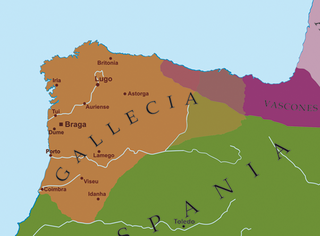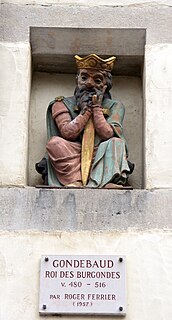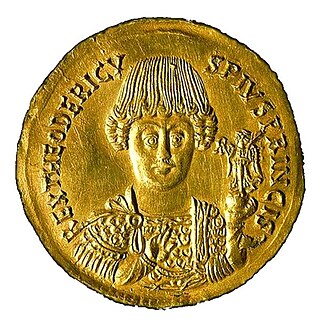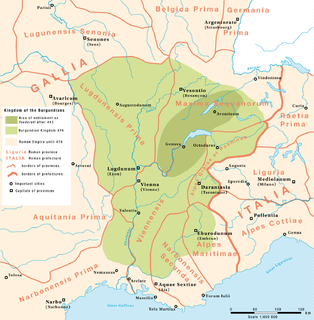
Year 476 (CDLXXVI) was a leap year starting on Thursday of the Julian calendar. At the time, it was known as the Year of the Consulship of Basiliscus and Armatus. The denomination 476 for this year has been used since the early medieval period, when the Anno Domini calendar era became the prevalent method in Europe for naming years.
The 470s decade ran from January 1, 470, to December 31, 479.

Year 430 (CDXXX) was a common year starting on Wednesday of the Julian calendar. At the time, it was known as the Year of the Consulship of Theodosius and Valentinianus. The denomination 430 for this year has been used since the early medieval period, when the Anno Domini calendar era became the prevalent method in Europe for naming years.
The 520s decade ran from January 1, 520, to December 31, 529.
The 570s decade ran from January 1, 570, to December 31, 579.
The 580s decade ran from January 1, 580, to December 31, 589.
The 480s decade ran from January 1, 480, to December 31, 489.
The 450s decade ran from January 1, 450, to December 31, 459.
Year 524 (DXXIV) was a leap year starting on Monday on the Julian calendar. At the time, it was known as the Year of the Consulship of Iustinus and Opilio. The denomination 524 for this year has been used since the early medieval period, when the Anno Domini calendar era became the prevalent method in Europe for naming years.

Year 584 (DLXXXIV) was a leap year starting on Saturday of the Julian calendar. The denomination 584 for this year has been used since the early medieval period, when the Anno Domini calendar era became the prevalent method in Europe for naming years.

Year 585 (DLXXXV) was a common year starting on Monday of the Julian calendar. The denomination 585 for this year has been used since the early medieval period, when the Anno Domini calendar era became the prevalent method in Europe for naming years.

Year 474 (CDLXXIV) was a common year starting on Tuesday of the Julian calendar. At the time, it was known as the Year of the Consulship of Leo without colleague. The denomination 474 for this year has been used since the early medieval period, when the Anno Domini calendar era became the prevalent method in Europe for naming years.

Year 473 (CDLXXIII) was a common year starting on Monday of the Julian calendar. At the time, it was known as the Year of the Consulship of Leo without colleague. The denomination 473 for this year has been used since the early medieval period, when the Anno Domini calendar era became the prevalent method in Europe for naming years.

Glycerius was Roman emperor of the West from 473 to 474. He served as comes domesticorum during the reign of Olybrius, until Olybrius died in November 472. After a four-month interregnum, Glycerius was proclaimed Western Emperor in March 473 by the magister militum and power behind the throne Gundobad. Very few of the events of his reign are known other than that during his reign an attempted invasion of Italy by the Visigoths was repelled, diverting them to Gaul. Glycerius also prevented an invasion by the Ostrogoths through gifts.

Year 575 (DLXXV) was a common year starting on Tuesday of the Julian calendar. The denomination 575 for this year has been used since the early medieval period, when the Anno Domini calendar era became the prevalent method in Europe for naming years.

Julius Nepos was de jure and de facto Western Roman Emperor from AD 474 to 475 and then only de jure until his death in AD 480. He was also the ruler of Roman Dalmatia from AD 468 to 480.

Gundobad was King of the Burgundians, succeeding his father Gundioc of Burgundy. Previous to this, he had been a Patrician of the moribund Western Roman Empire in 472 – 473, three years before its collapse, succeeding his uncle Ricimer. He is perhaps best known today as the probable issuer of the Lex Burgundionum legal codes, which synthesized Roman law with ancient Germanic customs. He was the husband of Caretene.

The Western Roman Empire refers to the western provinces of the Roman Empire at any time during which they were administered by a separate independent Imperial court; in particular, this term is used in historiography to describe the period from 395 to 476, where there were separate coequal courts dividing the governance of the empire in the Western and the Eastern provinces, with a distinct imperial succession in the separate courts. The terms Western Roman Empire and Eastern Roman Empire were coined in modern times to describe political entities that were de facto independent; contemporary Romans did not consider the Empire to have been split into two separate empires but viewed it as a single polity governed by two separate imperial courts as an administrative expediency. The Western Roman Empire collapsed in 476, and the Western imperial court in Ravenna was formally dissolved by Justinian in 554. The Eastern imperial court survived until 1453.

The Ostrogothic Kingdom, officially the Kingdom of Italy, was established by the Germanic Ostrogoths in Italy and neighbouring areas from 493 to 553.

The Kingdom of the Burgundians or First Kingdom of Burgundy was established by Germanic Burgundians in the Rhineland and then in Savoy in the 5th century.













